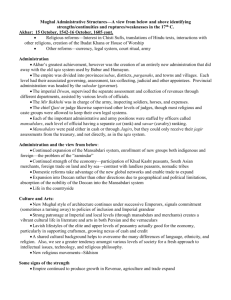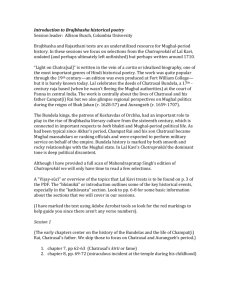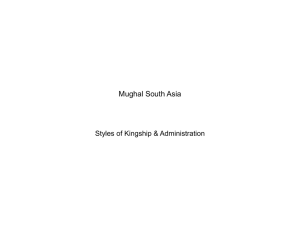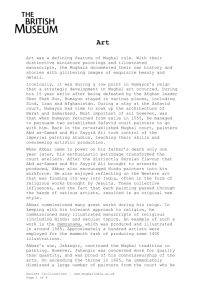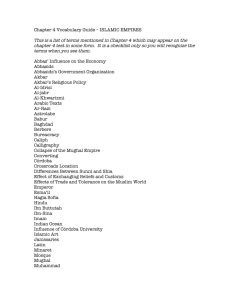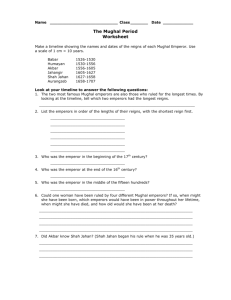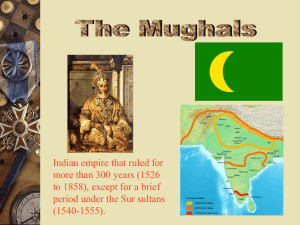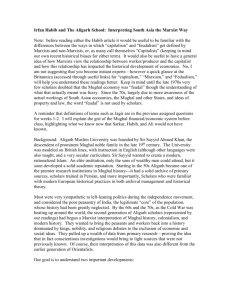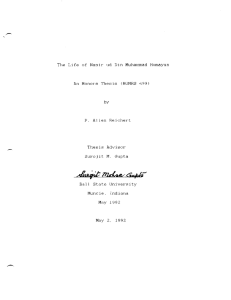The Princes of the Mughal Empire , 1504
advertisement
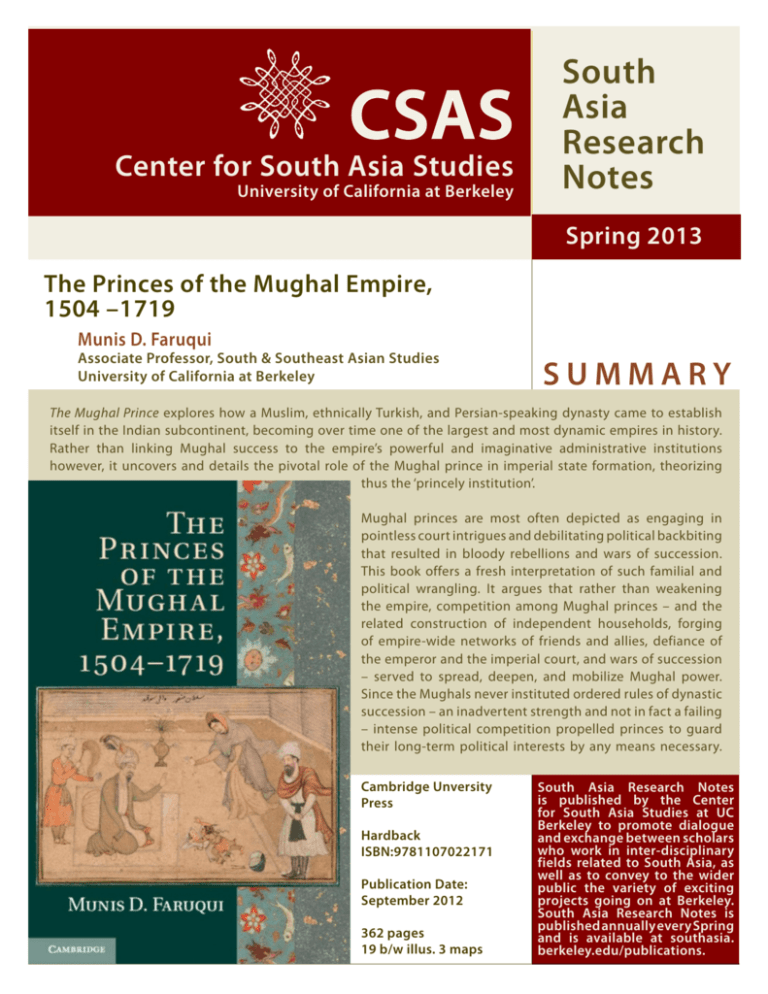
CSAS Center for South Asia Studies University of California at Berkeley South Asia Research Notes Spring 2013 The Princes of the Mughal Empire, 1504 –1719 Munis D. Faruqui Associate Professor, South & Southeast Asian Studies University of California at Berkeley SUMMARY The Mughal Prince explores how a Muslim, ethnically Turkish, and Persian-speaking dynasty came to establish itself in the Indian subcontinent, becoming over time one of the largest and most dynamic empires in history. Rather than linking Mughal success to the empire’s powerful and imaginative administrative institutions however, it uncovers and details the pivotal role of the Mughal prince in imperial state formation, theorizing thus the ‘princely institution’. Mughal princes are most often depicted as engaging in pointless court intrigues and debilitating political backbiting that resulted in bloody rebellions and wars of succession. This book offers a fresh interpretation of such familial and political wrangling. It argues that rather than weakening the empire, competition among Mughal princes – and the related construction of independent households, forging of empire-wide networks of friends and allies, defiance of the emperor and the imperial court, and wars of succession – served to spread, deepen, and mobilize Mughal power. Since the Mughals never instituted ordered rules of dynastic succession – an inadvertent strength and not in fact a failing – intense political competition propelled princes to guard their long-term political interests by any means necessary. Cambridge Unversity Press Hardback ISBN:9781107022171 Publication Date: September 2012 362 pages 19 b/w illus. 3 maps South Asia Research Notes is published by the Center for South Asia Studies at UC Berkeley to promote dialogue and exchange between scholars who work in inter-disciplinary fields related to South Asia, as well as to convey to the wider public the variety of exciting projects going on at Berkeley. South Asia Research Notes is published annually every Spring and is available at southasia. berkeley.edu/publications. After the 1580s in particular, and Emperor Akbar’s decision to discontinue granting royal heirs semi-independent territories (also known as appanages), princes scrambled to establish loyal followings, accrue wealth and influence, and build their political power and military strength across an expanding imperial terrain. The stakes were high; all knew that only one prince could ascend the throne and that the rest would die. Crucially, in the course of fortifying their own power in anticipation of a succession struggle, Mughal princes helped imprint and extend dynastic authority. The Mughal Prince explores these processes, bringing to Mughal historiography new ways of understanding Mughal imperial success and fresh insights regarding an institution, the princely institution, hitherto unnamed and undescribed. While the main focus of The Mughal Prince is on the central role of the princely institution in Mughal state formation, the book also demonstrates how the gradual sclerosis of that institution, starting in the late-seventeenth century, had a devastating impact on the dynasty. Once princes and their households along with Birth of Prince Salim (V&A Museum) their capacity to build alliances were compromised – due to a growing financial crisis, deliberate efforts by Emperor Aurangzeb to undermine his heirs’ ability to challenge his authority, and rising intergenerational strife – the robustness and reach of the empire also went into terminal decline. This book combines a longitudinal with a chronological organization. With the former, it identifies key themes in the story of the princely institution – the princely household; a prince’s friends and allies across the empire; his disobedience and rebellion; and finally his bid for the imperial throne. With the latter, this book identifies three main periods in the history of the princely institution: the early period (1504-1556), the high period (1556-1680s), and the late period (1680s-1707). Following the introduction, the first chapter traces the shifts in Mughal succession practices in each of these periods. While two of the remaining six book chapters focus on the early and late periods respectively, between them are four chapters that examine princely households, alliance building, Circumcision of Akbar (British Library) rebellion and succession, as these worked during the high period of Mughal rule. The book thus demonstrates that, in the thriving middle years of the empire, the princely institution too was at its zenith. The Mughal Prince draws on a vast archive. This includes European traveler accounts as well as the records of the English East India Company. However, the book is primarily based on Persian sources from the Mughal period, both published and archival, including: officially sanctioned court chronicles; privately written historical accounts; imperial memoirs; administrative documents; biographical dictionaries written by imperial noblemen and religious scholars; collections of imperial and noble correspondence; Sufi hagiographies; and local and regional histories. By far the most valuable archival resource is a thus far little utilized collection called the Akhbarat-i Darbar-i Mua‘lla (News Bulletins of the Exalted Court) in the National Library of India (Calcutta).. This consists of thousands of daily reports of the Mughal court and offers invaluable insights into the difficulties that buffeted the princely institution in the last decades of the Mughal emperor Aurangzeb’s reign (r. 1658-1707). The Mughal Family Tree Mughal Emperors & select Princes Munis Faruqui (Ph.D. Duke University) is a historian and Associate Professor in the Department of South and Southeast Asian Studies. He focuses on the Muslim experience in South Asia, especially during the Mughal period. Professor Faruqui’s books include Princes of the Mughal Empire, 1504-1719 (2012) and two forthcoming edited volumes: Religious Interactions in Mughal India (co-edited with Vasudha Dalmia) and Expanding Frontiers in South Asian and World History (coedited with Richard Eaton, David Gilmartin and Sunil Kumar). His various journal articles have interrogated the creation of the Mughal Empire under Emperor Akbar (r. 15561605), the founding decades (c. 1720-40) of the princely state of Hyderabad, and the relationship between religion and politics in the life and work of the Mughal prince, Dara Shukoh (1615-59). He is currently working on a book reevaluating the Mughal Emperor Aurangzeb (r. 16581707). Book Excerpt (p. 81-82) The Importance of a Prince’s Education T here probably is no better indication of the importance the Mughals attached to their princes’ education than the anger expressed toward bored or truant princes. Thus, after learning that his son Kam Bakhsh had been skipping his tutorials, Aurangzeb furiously reprimanded him: “A person without knowledge (bi-ilm) is a beast (haiwan). A prince, in particular, should have a refined mind.” After reproaching Kam Bakhsh, Aurangzeb ordered him confined to his personal quarters for a month and a half. A prince whose education was considered lacking was likewise stigmatized and shunned. Aurangzeb’s grandson Buland Akhtar, for example, spent much of his youth in the care of rebellious Rajputs after being abandoned by his father Prince Akbar following the latter’s failed rebellion in 1681. Upon his reunion with Aurangzeb and the Mughal court in the late 1690s, Buland Akhtar was deemed uneducated and uncivilized; one contemporary described him as possessing no restraint of speech or habit. It was a reputation that he was never able to shake. Young Prince (Smithsonian Institution) The Spread of the Mughal Empire (1530) (1605) (1707) Book Excerpt (p. 54-55) The Emperor and the Errant Prince: 1483 1493 Babur’s relationship with Humayun 1501 B 1504 1508 abur and Humayun may have enjoyed a warm and loving relationship while the latter was still a child. But any affection evaporated in the years following Humayun’s dispatch to Badakhshan (1519). Their drifting apart is apparent from the unusual silences in otherwise loquacious Mughal accounts. It is also attested to by Humayun’s decision to temporarily ignore his father’s summons to Kabul to participate in the long-planned invasion of India in 1525–6. Babur’s anger is clearly registered in his memoir, the Baburnama. The emperor noted that he sent his son “harshly worded letters.” When Humayun finally did arrive, his father gave him an earful: “I rebuked him quite a lot for being so late.” This was not the end of Humayun’s misbehavior, however. Although the historical sources are careful to not offer us any examples of Humayun’s troublemaking over the next few years, we know that Babur had grown tired enough of his son’s errant behavior to transfer him and his contingents out of India and back to Badakhshan in 1527. Although Babur explained his action by claiming that the Badakhshanis were exhausted from constant fighting, that Kabul was undermanned, and that he had made a prior promise to release the Badakhshanis once northern India was successfully conquered, these seem to be nothing more than excuses. For instance, the suggestion that Babur was concerned about Kabul’s vulnerability is suspect given that he was sending letters “in all directions” at that time pleading for additional troops to come to India. There clearly was little warmth left between father and son. Indeed, the Baburnama records the emperor’s greater interest in exploring the hot springs of Ferozpur than in bidding farewell to Humayun on the eve of his removal from India. 1519 1526 1527 1530 1540 1540 –52 1542 1555 1556 1570s 1583 Timeline of Key Events in Mughal History Birth of Babur in Ferghana (contemporary Uzbekistan) Babur becomes ruler of Ferghana upon death of his father Uzbeks defeat Babur; he is forced to vacate Samarqand Babur captures Kabul Babur assumes the title of padshah; birth of oldest son Humayun Badakhshan given to Humayun as his princely appanage Babur invades India; the Lodis defeated; the Mughal Empire established Babur defeats Rajput coalition under Rana Sangha at Khanua; Humayun sent back to Badakhshan, sacks Delhi treasury on way out Death of Babur; Humayun ascends throne Humayun defeated by Sher Khan Suri, flees India; Mughal rule collapses Humayun and Mirza Kamran battle for supremacy Birth of Akbar Humayun invades India, reestablishes the Mughal Empire Death of Humayun; Akbar ascends the throne Akbar introduces the mansabdari and jagirdari systems Akbar offers his sons first experience of running the Mughal Empire Salim’s rebellion 1599 –1604 1605 Death of Akbar; Salim/Jahangir ascends the throne 1606 Khusrau’s rebellion; imprisoned following capture 1607 Khusrau blinded; Khurram/Shah Jahan accorded adult status 1611 Jahangir marries Mehr-un-Nisa/Nur Jahan 1612 Khurram marries Arjomand Banu Begum (later Mumtaz Mahal) 1614 Khurram defeats Rajput kingdom of Mewar 1616 Khurram enjoys military success in the Deccan –17 1621 Khurram undertakes second successful –22 campaign in the Deccan Contd. overleaf Book Excerpt (p. 168-169) Life Away from the Imperial Court L ife away from the imperial court was not easy for princes, especially in their early years. Jahangir’s son Prince Parvez asked to return to court shortly after his first major appointment as commander of the Mughal forces against Mewar in 1606. The rigors of the campaign as well as the presence of a host of domineering Mughal nobles came as a shock to the young prince. Less than forty years later (in 1644), Aurangzeb simply abandoned his governorship of the Deccan Battle of Samugarh (Harvard Art Museums) and returned to court without permission. It seems he was exhausted and longed to be back in the imperial court. In 1646, Aurangzeb’s brother Murad also deserted his command in Balkh on the northwestern frontier. But despite the drawbacks of being and feeling out of touch with events at court, princes sometimes learned that in the bitter competition for the throne, certain advantages accrued to having relative independence. Thus, for a time, Akbar’s son Murad evaded his father’s efforts to bring him back to court from his command in the Deccan. As tensions with his father and stepmother, Emperor Jahangir and Nur Jahan, increased in the early 1620s, Prince Khurram in fact requested assignment to the Deccan. In 1645, after realizing how unwelcome he was at the imperial court, Aurangzeb begged his father’s chief minister Sa‘dullah Khan to assign him anywhere so long as it was far removed from the court. Book Excerpt (p. 103) The Prince and His Household E Shah Shuja’ (Smithsonian Institution) very adult Mughal prince – barring the disgraced or imprisoned – possessed his own household. These varied in size from a few individuals for princes of collateral imperial lines to the megahouseholds of the direct heirs of an emperor. Such grand princely households could encompass thousands of individuals. After the 1580s, exercising their tentacle presence across the entire empire, these households exerted enormous political influence. Their strength, size, and combined capabilities helped determine the political fortunes of the small group of princes jockeying to be the next emperor. On the basis of his household wealth and the effectiveness of his retainers, a prince might establish his reputation as a general, project his power in times of peace and war, accomplish delicate political missions, build ties to powerful individuals or groups, and broadly make the case for his suitability to be the next emperor to imperial subjects of every status. Book Excerpt (p. 240) Fratricide: The Case of Salim & Danyal A lthough no historical account directly implicates Salim in the death of Danyal in March 1605 – a mere seven months before Akbar’s own demise in October 1605 – circumstantial evidence suggests otherwise. Danyal was a longstanding alcoholic, and by late 1604 his alcoholism had gotten so bad that he was constantly ill and weak. In a desperate attempt to control his son’s habit, Akbar had ordered Danyal to be placed under house arrest in the Deccan. Somehow, rust and lead-laden (in effect poisoned) alcohol was smuggled into the prince’s quarters by a group of “wicked persons” who, according to the Akbarnama, “seeing their own good in his harm . . . conspired to kill” the prince. Among those involved in the plot were a nephew of Khwaja Fathullah and a brother of Zamana Beg (later Mahabat Khan), both diehard supporters of Prince Salim. Three days after Danyal’s death and following a public trial, ten men were publicly beaten and stoned to death by Danyal’s aggrieved supporters. This brutal form of capital punishment was most likely employed because of the conviction that the men had acted on Salim’s orders. With Danyal’s death, Salim became Akbar’s sole surviving son and de facto heir to the throne. 1622 –27 1626 1627 1628 1636 –44 1644 Khurram’s rebellion Rebellion of Mahabat Khan Death of Jahangir; war of succession follows Khurram/Shah Jahan ascends the throne Aurangzeb serves as governor of the Deccan Aurangzeb returns to imperial court without permission, stripped of rank 1646 Failed Mughal campaign against Balkh and –47 Badakhshan 1649 Failed Mughal campaigns against Qandahar –53 1652 Aurangzeb serves as governor of the Deccan –57 1656 Aurangzeb wages war against kingdoms of –57 Bijapur and Golkonda 1657 War of succession involving Shah Jahan’s four –59 adult sons 1658 Shah Jahan forced to abdicate, imprisoned in Agra; Aurangzeb ascends the throne 1659 Muhammad Sultan’s rebellion, imprisoned until death in 1676 1681 Akbar rebels 1685 Mughal campaigns against Bijapur and –87 Golkonda 1687 Mu‘azzam imprisoned by Aurangzeb –95 1690s Emergence of Ghazi-ud-Din Khan, Chin Qilich Khan, and Zulfiqar Khan as key imperial generals 1693 Kam Bakhsh placed under house arrest for a brief time 1700 All major princes removed from command –02 positions in the Deccan 1701 A‘zam serves as governor of Gujarat –15 1707 Death of Aurangzeb; war of succession follows; Mu‘azzam/Bahadur Shah I ascends the throne 1712 Death of Bahadur Shah; war of succession ensues; Mu‘izz-ud-Din/Jahandar Shah ascends the throne with the help of Zulfiqar Khan 1713 Jahandar Shah overthrown; Farrukh Siyar ascends the throne; Sayyid brothers emerge as most powerful nobles in the empire 1719 Farrukh Siyar overthrown; Sayyid brothers successively appoint Rafi‘-ul-Darjat and Rafi‘ul-Daula as emperors; end of the open-ended system of succession The Center for South Asia Studies (CSAS) at the University of California, Berkeley is one of the world’s foremost centers for research and programs on South Asia. CSAS works with faculty members, graduate students, community members, private institutions, and nonprofit organizations to deepen understanding of the region and to create new generations of scholars of South Asia. One key area of focus at CSAS is research about and programmatic activities on contemporary South Asia, examining closely issues like democracy and democratic reform, reduction of inequality, and social development. CSAS Center for South Asia Studies University of California at Berkeley 10 Stephens Hall Berkeley, CA 94270 southasia.berkeley.edu 510 642 3608 South Asia Research Notes Princes of the Mughal Empire,1504-1719 Table of Contents List of Maps and Illustrations — page viii Acknowledgments —ix Mughal Family Tree —xi Chronology —xiii Note on Transliteration and Translation —xviii Introduction —1 Prologue: Setting the Stage, 1504-1707 —14 The Early Years, 1504-1556 —46 Princely Households — 66 Friends and Allies —134 Disobedience and Rebellion —181 Wars of Succession —235 The Prince Shackled, 1680s-1707 —274 Conclusion —309 Bibliography —327 Index —341
